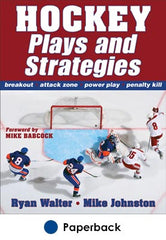Tips and plays to help create an active defense
This is an excerpt from Hockey Plays and Strategies by Ryan Walter & Mike Johnston.
Activating Defense in the Offensive Zone
Much like other aspects of offensive play, coaches have to decide how comfortable they are with getting their Ds involved in the offense. Basically, how much risk do they want to take? If the offensive team has quality puck possession, there is little risk in allowing the defense to move in offensively. You have to teach your players to make good decisions with the puck and trust that they will make a safe play rather than a dangerous play. The key rules for defensemen that will help minimize risk are as follows:
1. Only one D at a time goes deep into the offensive zone.
2. Read the time of the game and the score—Ds should be more cautious when moving in offensively late in periods or when your team has the lead.
3. The forwards must have quality puck possession in order for the defense to activate.
4. When the defense move in, if a pass is not made do not “hang out”—get back to the blue line quickly.
Attack Zone Plays
This section describes special plays made in the offensive zone using an active defense. The plays are all effective and provide a variety of options.
Strong-Side Slide
D1 reads that F1 is cycling out of the corner, so he slides down the boards and receives an exchange pass from F1. The exchange is like a handoff in football, where the puck carrier protects the puck and gives it to D1. D1 now has the option of driving the net with the puck or cutting behind the net with possession and looking for a passing option (figure 4.6). F1 should cycle out high and remain in a defensive position until D1 recovers.
Midseam Penetration
When D1 sees the defensive team overplaying the boards, he should slide into mid-ice and down through the slot toward the net. F1 should use deception by looking as if he will pass to the point and then making a quick pass to D1, who is moving through the middle of the slot. D1 may have an opportunity to shoot quickly or move in deeper (figure 4.7). Once again F1 should move out to a higher defensive position after the pass in case of a turnover.
Back-Side Slide
When the offensive player (F1) has the puck and D2 reads that the defensive team is overplaying one side of the ice, D2 should quickly move down the back side and be ready for the pass. F1 tries to find an open seam to thread the pass through to the wide side. If D2 doesn't get the pass when moving in, he should get out immediately. Once again, this play should be made quickly and with deception so that attention is not drawn to the defenseman moving in. This is a riskier play because of the distance of the pass and the number of players in the area but if D2 gets the pass clean he will have a great scoring chance (figure 4.8).
This is an excerpt from Hockey Plays and Strategies.
More Excerpts From Hockey Plays and Strategies

Get the latest insights with regular newsletters, plus periodic product information and special insider offers.
JOIN NOW


